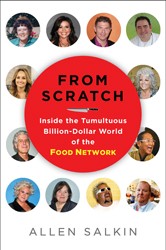One might classify William Handwerker’s Nathan’s Famous in numerous ways. It is at once a paean to the Handwerker family, beginning with Nathan who immigrated to Brooklyn at the dawn of the twentieth century and founded what has become an iconic international corporation; a social history of Jewish immigrants from Eastern Europe and their assimilation into New York City and its suburbs; an insightful exploration of food service and the restaurant business; and a primer to growing a business from a one-man venture into an international enterprise.
Most readers will be familiar with Nathan’s Famous as the delicious hot dog associated primarily with Coney Island, its birthplace. What few readers will be aware of, however, is the enormous amount of thought, skill, and planning involved in the hot dog’s production and distribution, the baking of the roll on which it is served, and the cooking of the fries that often accompany it — all before one can actually buy a hot dog in a desirable location for a reasonable price. Handwerker introduces the reader to the challenges his family encountered and describes how his grandfather, father, and other relatives pitched in to solve them. Along the way, he also discusses the pros and cons of operating a family business and how this may impact relationships between parents and children and among siblings.
As the Nathan’s Famous enterprise grew, so did its problems. Handwerker takes the reader through the agonizing times when the entire business was on the verge of failing, and he shares some of the difficulties the family faced in deciding on locations, obtaining financing, “going public,” and then privatizing once again. He discusses their franchising and licensing programs, and what it was like for the owners of a relatively small family-owned business to find themselves negotiating with major international corporations.
Possibly because of the skill of Jayne Pearl, the book reads as though William’s grandfather, Nathan, or father, Murray, were sitting in an armchair across from the reader and reminiscing about his life and career. This feeling is enhanced by the “Frank lessons” shared with the reader at the end of most chapters. Here are three of many examples:
(1) “Be aware of trends in your industry as well as the areas in which you operate, so you can adjust the course, take advantage of new opportunities or decide when it’s time to cut your losses.”
(2) “You can’t win ‘em all. Do your best to play to your strengths and remain focused on your ultimate goals.”
(3) “Always be honest and forthcoming with your business partners. It is these relationships that support your business.”
Finally, one of the most charming aspects of this highly readable book is the many photographs that introduce the reader to people and places mentioned in the text.
Related Content:





